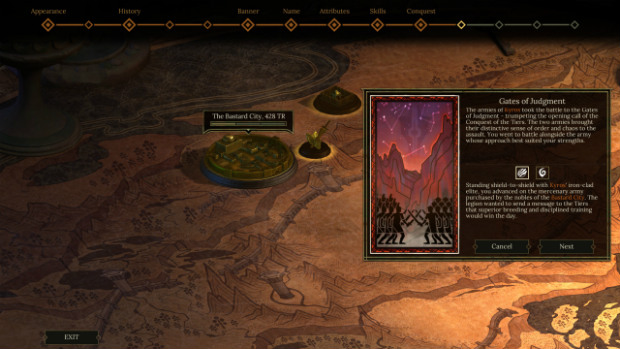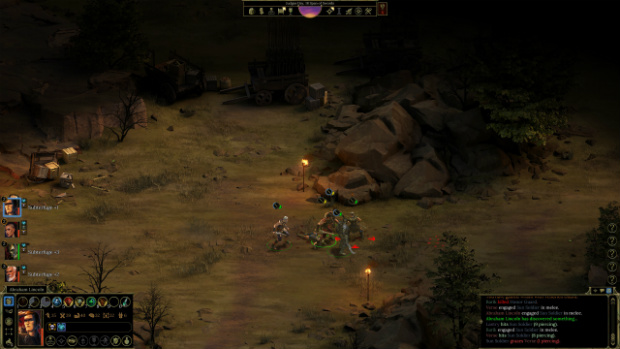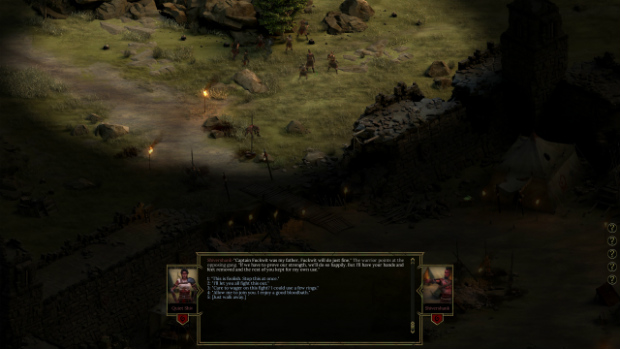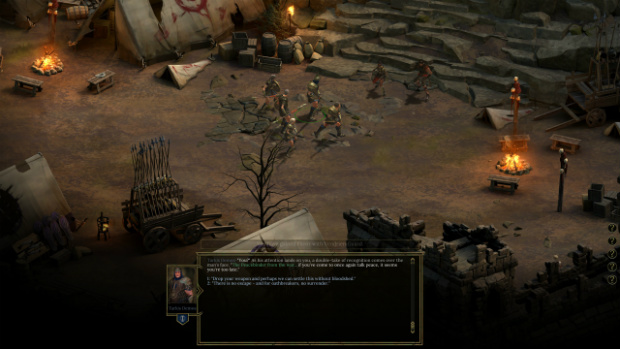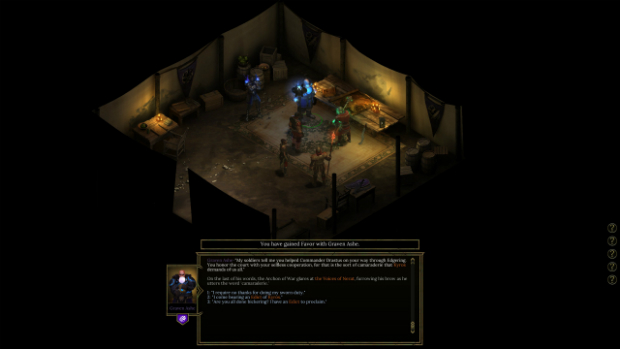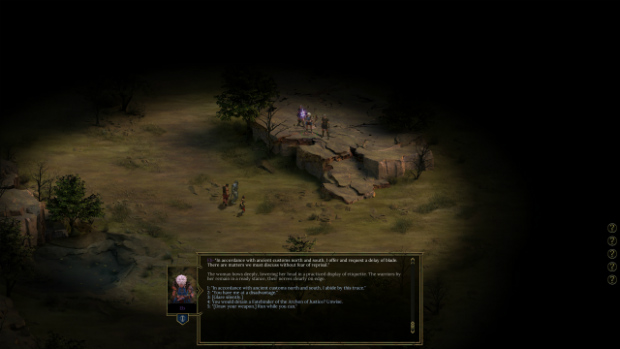In Tyranny, It's Good To Be Evil
Hands-on with Tyranny's early hours
Evil in Tyranny [official site] is so ordinary. That’s why it's successful, I think. In a medium prone to cartoonish overexaggeration, where villains are barely more than mustache-twirling caricatures, Tyranny tells a bleaker story. It’s the evil of numbers, the evil of tax collectors and bureaucracies and negligence and “I was just following orders.” A real-world sort of evil. The type that’s much harder to stomach.
The type that, when you’re given the chance to go hands-on with Tyranny’s first few hours, leaves you unsettled.
That was me, this past week. Obsidian invited press to come play the first two-ish hours of Tyranny, including character creation and the “Conquest” prologue. It made for a much quieter demo than the combat-centric bit Adam saw back at Gamescom.
A much darker demo, too. Last time Adam saw Tyranny he said “It’s not necessarily a game about playing the villain.” True enough.
You do work for the villain though, the seemingly all-powerful Overlord. You’re a Fatebinder — part judge, part police officer, part military general, part adventurer-for-hire. One of the highest authorities in the land, you navigate conflicts between various factions and enforce the will of the Overlord in whichever way you see fit.
And that means (at least in the early game) doing some things you regret. Character creation is a rote affair — adjust appearance, dole out some points, give yourself a name — but Tyranny also has you take part in world creation. In the Conquest prologue you help lead the invasion of Tiers, the last free realm in the land.
It plays out like a short Choose Your Own Adventure, blocks of text conveying both the day-to-day of camp life and the massive battles you fight in. Your choices here will affect the state of Tiers when the game actually starts, as well as how various factions respond to you.
Do you allow the Overlord’s elite troops, the Disfavored, to assault a city head-on? Or do you let the Scarlet Chorus lock the gates and burn everyone inside alive? Do you enslave the survivors or allow them to enlist in the army?
Of six locations total, you have the possibility to affect three in a single Conquest run, with each location subdivided into a few smaller Choose-This-Or-That events. The ones you don’t go to? “If you don’t go to a place it assumes another Fatebinder did and they did the worst possible thing,” said Obsidian’s Brian Heins. “If you go to a place, you have the chance to be more merciful.”
Make no mistake though: “More merciful” does not mean “Saintly.” Evil is a fact of life regardless, and the Conquest of Tiers an inevitability. Within five minutes of creating my Fatebinder I’d already starved half my army in the name of “fairness,” enslaved one city, and destroyed another with a storm so fierce they stopped calling the area “Stalwart” and started calling it the “Blade Grave.”
In that last instance, my “merciful” action was to give the local populace three days warning before utterly obliterating the city, the land, and its leaders. A model of restraint, I tell you.
What’s even harder to swallow is that these actions are entirely justified by Tyranny’s lore. There’s an interesting disconnect between the game and the player. As outsiders, we might recognize “burning down an entire city with its population inside” as a work of immense evil, but Tyranny doesn’t present it that way. You’re the hero, delivering the Tiers into the hands of Overlord by any means necessary.
“We try to confront the player with situations that have meaningful context,” said Heins. “We didn't want ‘evil for evil's sake,’ but rather choices that may seem like extreme solutions to a problem — or be perfectly reasonable, depending on your point of view.”
As I said up top, it’s a much more complex depiction of Evil. One with nuance, with motivations that go beyond the BioWare-esque “You can either save this orphanage or kill them all (and eat them).”
I began classifying Tyranny’s factions by the old Dungeons & Dragons alignments. The Disfavored, a strict and regimented army in the style of Imperial Rome, are Lawful Evil. They’re the evil of bureaucracies, an ordered affair that can stand on honor and tradition even while claiming the massacre of innocents is a tactical necessity.
The Scarlet Chorus is more Chaotic Evil, an army of former slaves and criminals and low-lifes loosely tied together by a hierarchy based on fear. They win by way of sheer numbers, not training, and they’re defined by paradoxes — both more brutal to their enemies and more accepting of turncoats, for instance.
They’re both evil, but the methods are very different. And as the Conquest wraps up, its your relationship with both factions that drives the early parts of the game proper. Two years post-Conquest, the land of Tiers might be conquered but its people are certainly not, and the first act of Tyranny kicks off with a revolt.
The ragtag rebellion should be an easy fight, but the Disfavored and the Scarlet Chorus can’t agree on tactics. As a result, the Overlord’s massive armies sit stagnant while the opposition grows stronger. You’re sent down to the Tiers to — *ahem* —convince the two armies to work together.
Your weapon? An Edict. Basically a magical contract infused with the Overlord’s power. This one’s addressed to the leaders of the Disfavored and Scarlet Chorus, and says “Stop wasting time fighting each other. Take over this city within eight days or everyone in the entire valley will die.”
Yes, it’s an actual time limit a la Fallout. Once you’ve read this edict, a counter pops up at the top of the screen informing you how many days are left until all life is extinguished. Time passes whenever you leave to go to a new area (a.k.a. when traveling), and if you don’t accomplish your goal before the eight days is up?
“The game ends,” said Heins. “If you are really good and know where to go you absolutely can do everything in that eight days, though it starts getting tight.”
“We wanted the replayability and playing different paths though, and having a time limit creates a sense of urgency that maybe you don’t want to do everything. And with Kyros and the Edicts,” he continued, “we wanted to add some visual presence. The time limit felt like a good way to show this is actually urgent.”
As for whether you’ll see other time limits later, Heins said Obsidian’s experimenting with a few but they may or may not make it into the final release —and they might not all be game-ending catastrophes. “Others may just change the overall state, or what the win conditions can be. But we’re still evaluating that.”
The greater ramifications of that eight-day time limit will need to be explored in reviews. I didn’t get near that far in my own demo, and actually used my two hours with Tyranny to play the first hour twice, mainly because I shared Adam’s trepidations — as he said, “In a game that’s so keen to gesture toward the bigger picture, it can be difficult to get a sense of how well the smaller moments work toward that end” during a demo.
That’s still true. An hour with Tyranny is not nearly as useful as ten hours with Tyranny is not nearly as useful as two full-length runs through the game, and et cetera.
You can start to see the shape of Tyranny in just two hours though. My first time through the prologue, for instance, I opted to visit the city of Apex and, with my well-honed diplomatic skills, managed to hash out a peaceful surrender of the armies within. Later, upon encountering the revolutionary troops in the actual game, they called me “Peacebinder” and were willing to negotiate with me.
My second time through I avoided Apex entirely, and all those dialogue options disappeared. No more Peacebinder, no mentions of how honorable I was, and the revolutionaries were enraged at how poorly the city had been treated under one of the Overlord’s other emissaries.
These aren’t the “Entire sections of this city are missing” world-shattering effects teased by the prologue (and by Obsidian in past Tyranny demos). But you can already see the causality, the road that led from your actions to the game’s response — and within mere minutes.
Skill checks are similarly prevalent, be it a boulder I could push onto an enemy to thin out a combat encounter or a wall I could climb for hidden treasure. These environmental interactions are littered all over Tyranny, whereas in Pillars of Eternity they often felt like an afterthought or a late addition.
Between the small dialogue touches and the ever-present skill checks, my impression is a game where character really matters. You will not be able to see everything Tyranny has to offer in one playthrough. It’s simply not possible. There’s a natural parallel between Tyranny and Fallout: New Vegas in that respect, though here the various factions are less “shades of gray” and more “shades of black.” I’m looking forward to delving those depths.

